What is QoS? How to use QoS to get faster Internet speed when you need it urgently
TipsMake.com - In the article below, we will introduce and guide you to learn about the concept of QoS - Quality of Service on router devices.
What is QoS?
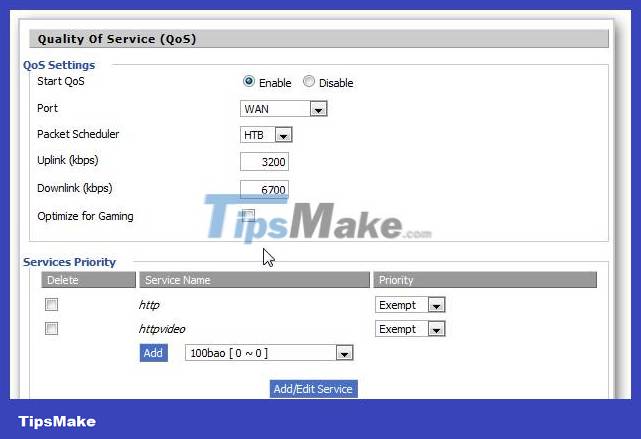
QoS (short for Quality of Service), is a way to control the traffic priority level of the network system. This feature works on all different layers of the system, but in this test, we We will focus on router devices used in home or personal models. More specifically, QoS will clearly show its effect in locations where bottlenecks often occur (or more commonly known as bottlenecks), and at the same time decide which part of traffic is more important than the rest, based on based on the rules that the user sets related to IP address, MAC address, active services.
Real-life QoS use cases
To understand a little better, let's take the example of traffic jams on the highway during rush hour. All drivers on the road have one goal, which is to reach their final destination. And so they have to keep moving, albeit at a snail's pace.
Then the sound of an ambulance siren alerted them to a vehicle that urgently needed to reach its destination and had to get ahead of them. Therefore, drivers move away from the place - which now becomes the "priority road" of the ambulance - and let it pass.
Similarly, when a network transmits data, it also has a setup in which some types of data are handled better than all others. Critical data packets need to reach their destination much faster than the rest, as they are time-sensitive and will 'expire' if they do not arrive on time.
Why is QoS important?
In the old days, information networks and business networks were separate entities. Telephone calls and remote communications are typically handled by a network RJ11 connection. Calls are monitored by a PABX system. It runs separately from the RJ45 connected IP network that links laptops, desktops and servers. These two types of networks rarely intersect unless, for example, a computer needs a phone line to connect to the Internet. An example of such a network would look like this:

When the network only transmits data, speed is not so important. Today, interactive applications that carry audio and video must be delivered over the network at high speeds, without packet loss or variation in delivery speed.
Now, people make business calls using online meeting applications like Skype, Zoom and GoToMeeting, which use the IP transport protocol to send and receive video or audio messages. For the sake of speed, these mission-critical applications can perform without the management processes that standard data transfers typically require.
Where does bottleneck often occur?
The main operating mechanism of QoS is often applied when a bottleneck phenomenon occurs at a time or somewhere in the system, and the main factor here is the parameters you set related to bandwidth :
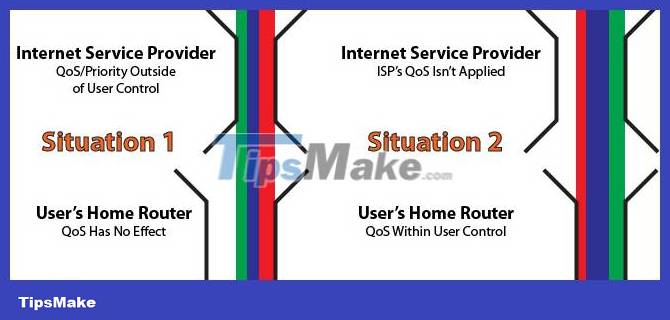
Assume that the initial QoS settings exceed the bandwidth you receive from the provider. What happens if the traffic on your router is not prioritized because the system 'thinks' that this bandwidth traffic is completely reasonable. Meanwhile, if you've maxed out your ISP's supply limit, they're the ones who decide what is and isn't allowed to continue operating.
Besides, if you set the QoS bandwidth level lower than the ISP standard, it means you are creating 'artificial' bottlenecks, and we can control, monitor and monitor them through router. router.
Some points to note to ensure stability in the system, including Uplink and Downlink settings :

Let's start by checking the average connection speed we are using from the ISP. To do this, you can use some available online support services such as Speakeasy Speed Test and SpeedTest:

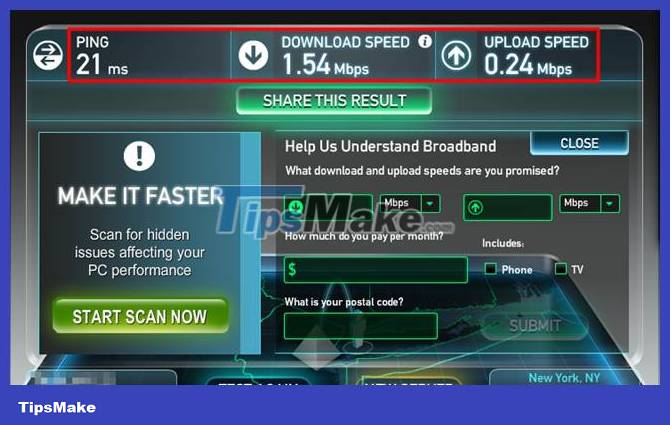
According to the recommendations of experts as well as many experienced users, you should set QoS at about 85% of the value obtained from the test to ensure the system operates effectively. After determining the Uplink and Downlink speeds , gradually increase them by about 1-2% each time. For some special cases, users can increase up to 95% while the system still ensures performance, without being affected by any side effects.
What happens if QoS is not used in the network?
Not having QoS configured correctly can lead to one (or all) of the following issues:
Latency
When RTP packets have not been assigned the required priority, they are delivered at the device's default rate. In a congested network, packets must travel along with the rest of the non-urgent packets. While network latency itself will not affect the quality of the audiovisual data delivered, it will affect communication between end users. At a latency of 100ms, one person will start talking over the other person as packets arrive out of sync, and at 300ms, the conversation will be unintelligible.
Jitter
Real-time applications eliminate standard transport-level buffering, so there is no mechanism to reassemble incoming packets in the correct order. Jitter is the irregular speed of packets on a network. It can lead to packages arriving late and out of sequence. Because the application does not wait for the stream to be ordered correctly, out-of-sequence packets are skipped, leading to distortions or gaps in the delivered audio or video.
Packet loss

This is the worst case scenario which sees that some (or part) of the packets are lost due to too much congestion on the network devices. When a switch or router's output queue is full, Tail Drop occurs when the device discards any new incoming packets until capacity is available again.
In all the cases you just saw, QoS can help by organizing data, managing queues, and preventing data loss.
It's not hard to imagine how communication and streaming media or streaming content could be severely affected by not using QoS - especially on networks serving the RTP protocol. Even if it were designed perfectly, eventually communication would first become difficult, then deteriorate as network traffic increases, and finally become impossible.
The three errors mentioned are in fact very important in determining the quality of traffic based on RTP, which QoS and network monitoring software companies like SolarWinds use as a measure.
Network tool for QoS monitoring
SolarWinds NetFlow Traffic Analyzer (Free Trial)
It would be quite unfair to continue without mentioning a little more about one of the best network monitoring tools available: SolarWinds NetFlow Traffic Analyzer.
This suite of network monitoring applications helps solve problems that can be caused by:
- Slow network : A slow network can impact a business because it further reduces data transfer speeds. Unless network bottlenecks are removed, the entire organization will experience poor connectivity.
- Slow communication process : A business that cannot establish a clear communication channel within its network will be paralyzed. Worse still, the inability to communicate clearly with customers will almost certainly get a business into trouble.
- Unmonitored network : Administrators who cannot monitor the network properly will not be able to know about the current state of the network or how to plan for future network expansion. Without monitoring the network and tracking the performance of each device, network managers cannot make informed decisions and are likely to exacerbate network performance problems.
Armed with Netflow Traffic Analyzer, network administrators will be able to solve commonly encountered problems, as this tool helps:
- Helps implement QoS and optimize it - through data flow feedback
- Review and report on current QoS policy configuration, informing design decisions.
- Monitor bandwidth usage to determine which applications and devices are taking up network resources - these applications and devices can be isolated, rescheduled, or disabled.
The typical Netflow Traffic Analyzer dashboard contains important information that administrators need to monitor statuses and make quick settings adjustments. An example:
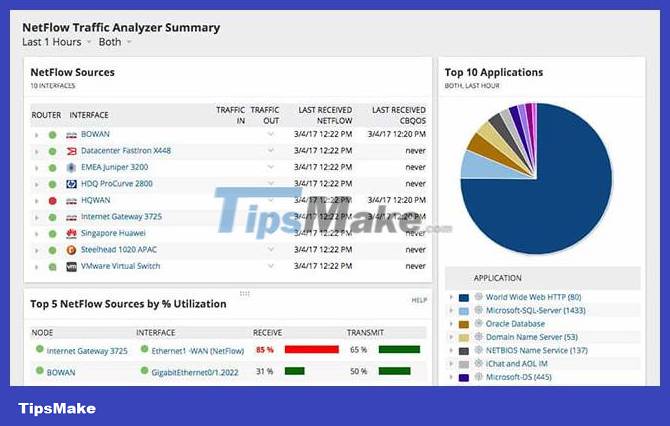
These reports and analytics include: Latency, Jitter, and packet loss.
Paessler PRTG
Another option you can use for QoS monitoring is Paessler PRTG. This network monitoring toolkit has a special section that monitors QoS performance. This function shows you tagged traffic flows in real time, and it also stores data for performance analysis and capacity planning.
PRTG software includes 4 monitoring sensors, including 3 different QoS methods. They are supplemented with a Ping Jitter sensor that monitors the regularity of packet delivery within a stream.
The 3 types of QoS that PRTG can monitor are standard QoS, Cisco IP-SLA, and Cisco CBQoS. Standard QoS monitors are applied as unidirectional sensors or Round Trip sensors. These trackers can operate on connections throughout the Internet.
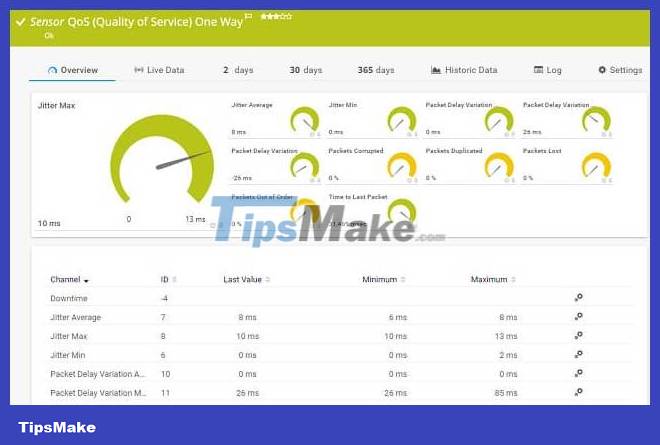
Cisco IP-SLA sensors are specialized for monitoring tagged VoIP traffic on your network. It records a variety of metrics for voice traffic, including round-trip delay, latency, Jitter, and Mean Opinion Score (MOS).
Cisco CBQoS sensors follow a layer-based Quality of Service implementation. CBQoS is a queuing method and if you want to implement it, you will have to monitor multiple entry points on your routers and switches. You create at least 3 virtual queues for each device, so there's more to keep track of.
PRTG can automatically set up and map all of your network infrastructure. However, implementing QoS requires decision-making, so you'll have to set up your own approach by deciding which types of network traffic to prioritize.
Paessler lets you use PRTG for free if you only activate up to 100 sensors. If you need more, you can try the system for free for 30 days, which includes QoS monitoring.
How to configure QoS?
Cable routers and switches can be configured to prioritize protocols commonly accessed by the router management software suite. The entire process of configuring QoS options is a fairly simple task that includes:
- Log in to the application and connect to the hub or switch through it
- Navigate to the QoS configuration menu
- Set package preference
And so, media packets will be able to transmit over the network smoothly. Hardcore network engineers can perform all of the tasks listed above through the command line configuration interface.
How are RTP packages prioritized?
QoS packet prioritization can be done using two main methods:
- Classification : This efficient method identifies packet types and assigns their priority by marking them. Determination can be done using ACLs (Access Control Lists), LAN implementations using CoS (Class of Service) or with the help of switches using hardware-based QoS marking.
Queues : Queues are high-performance memory buffers found in routers and switches. Packets passing through them are kept in dedicated memory areas as they wait to be sent. When protocols such as RTP are assigned a higher priority, they are moved to a dedicated queue that pushes data up at a faster rate, thereby reducing the risk of being dropped. Lower priority queues do not get this 'treat'.
An important thing to be remembered here is that a packet's priority marking is only valid in the network in which it was created. When it leaves the network, the owner of the receiving network determines its new priority.
Things to consider when prioritizing packets
Some things and tips that may be helpful when deciding how to prioritize plans include:
- It's usually a good idea to have priority markers assigned by the devices closest to the data source. This ensures packets travel across the entire network with the correct priority.
- The device chosen to mark incoming packets must always be a switch. This is because these devices can load-balance traffic on the network and share the burden with other switches, thus reducing the burden on their CPU.
- Incoming traffic is almost always greater than traffic going in the opposite direction. ISP providers typically assign less bandwidth to customers' outgoing traffic, and it is there (on the outgoing network path) that QoS primarily needs to be applied.
Cisco has a recommendation for how packets should be marked as shown in this diagram:

Ultimately, the success of a QoS implementation always depends on the quality of the policies that govern how packets are classified, marked, and queued. Policy must be carefully drafted for QoS implementation to be successful.
What should QoS not be used for?
After reading about QoS, you might think of it as a panacea for network congestion related problems. To a certain extent, QoS can make most RTP communications smoother and seems to have streamlined traffic on the network. Unfortunately, QoS is not a comprehensive solution to every network problem.
Never use QoS for the following purposes:
Increase bandwidth
While QoS helps prioritize RTP packets and makes it look like the network suddenly increased its bandwidth, never take things that way. QoS should never be used as a tool to 'increase bandwidth', when all it does is use existing resources a little more efficiently (and benefits RTP packets).
Instead, consider caching files to reduce the amount of incoming and outgoing data. If that doesn't work, it means the specified bandwidth limit has been reached. When a company hits its broadband limit, the only viable option is to go out and buy some more network equipment, not to use QoS.
Helps the network not be congested
If some applications are still running and are slowly consuming network bandwidth, implementing QoS is not the solution. While Skype calls may eventually start being made, QoS won't solve the root problem. Ultimately, applications will 'gobble up' any available resources, negating the benefits of QoS.
One solution that might work here is to look for resource-hungry apps and shut them down or reschedule them to run after work hours.
Again, the whole purpose of configuring QoS on a network is to ensure streaming video and audio calls don't lag (or even crash) due to network congestion. QoS is not a tool that can actually increase bandwidth. It also cannot go through a congested network.
A good QoS implementation improves the quality and speed of mission-critical data by optimizing allocated bandwidth, facilitating the tagging of packets so they can be identified, and given priority. specified first. QoS uses available bandwidth, but does not scale them.
Frequently asked questions about QoS in networks
What is the difference between QoS and Network Throttling?
Throttling, also known as policing, involves setting an overall limit on traffic throughput and reducing excess traffic levels. QoS is a method of prioritizing some traffic over others and using queuing, thereby maximizing the bandwidth for some traffic at the expense of the bandwidth of other traffic.
What is the main role of DSCP in QoS?
Differentiated Services Code Point (DSCP) appears in the packet header. This is a packet-level opportunity to request priority from QoS management software on network devices. The network manager can choose to enable or disable DSCP discovery on the device, so this value can be ignored in favor of another QoS queuing method.
Can you explain traffic shaping in QoS?
Traffic shaping is a method used by QoS to get the best value from network capacity. All networks experience spikes in demand, and traditional capacity planning requires providing the highest level of bandwidth plus a margin of safety. QoS traffic shaping causes small delays on certain traffic to allow a network with less capacity than peak demand to accommodate all traffic.
Good luck!
You should read it
- Make sure you can't get rich if you're still conservative with these 15 thoughts
- Useful shortcuts for Google Docs
- New feature in Windows 8 for laptop users
- How to install the application on Android without using Google Play Store
- Toshiba launched a series of cheap laptops from VND 6.4 million
- How to install Kali Linux reduced version
- 10 tips to change the registry in Windows XP and Vista
- Why are there identical twins, some are not?
May be interested
- How to Double Your Internet Speed
 internet speed is measured typically by download speed, upload speed, and latency. internet service providers (isps), when signing a contract with a new user, usually offer internet service packages that establish your maximum download and...
internet speed is measured typically by download speed, upload speed, and latency. internet service providers (isps), when signing a contract with a new user, usually offer internet service packages that establish your maximum download and... - How fast should your Internet connection be?
 today, with the development of technology, the speed of network systems such as fiber and 5g can easily reach gigabit per second, but in fact, how much bandwidth do we really need?
today, with the development of technology, the speed of network systems such as fiber and 5g can easily reach gigabit per second, but in fact, how much bandwidth do we really need? - How to Increase Internet Speed
 this wikihow teaches you how to increase your internet's speed and consistency. while it isn't possible to increase your internet's speed past the speed for which you're paying your internet service provider, most people don't get the most...
this wikihow teaches you how to increase your internet's speed and consistency. while it isn't possible to increase your internet's speed past the speed for which you're paying your internet service provider, most people don't get the most... - Vietnam Internet speed is slowest in Asia
 along with investment in improving electric lines, transportation, schools, and toilets, vietnam may need to invest more in super high-speed information because of the latest survey results, the speed of internet connection. vietnam is the slowest in asia, just above india.
along with investment in improving electric lines, transportation, schools, and toilets, vietnam may need to invest more in super high-speed information because of the latest survey results, the speed of internet connection. vietnam is the slowest in asia, just above india. - Common Mistakes When Performing Internet Speed Tests
 if the results seem slower than expected, don't be too quick to blame your isp - mistakes when performing the test can skew your numbers.
if the results seem slower than expected, don't be too quick to blame your isp - mistakes when performing the test can skew your numbers. - How to Check Internet Speed
 this wikihow teaches you how to see the upload speed and download speed of your internet connection, as well as the speed of the connection between your computer and your router. knowing your internet speed can help you figure out what you...
this wikihow teaches you how to see the upload speed and download speed of your internet connection, as well as the speed of the connection between your computer and your router. knowing your internet speed can help you figure out what you... - What is 1.1.1.1? How does it speed up the Internet and secure data when browsing?
 dns resolver 1.1.1.1 is a dns service that helps speed up cloudfare's internet. this service was developed to fix the internet by building a faster, more secure and privacy-preserving public dns resolver service.
dns resolver 1.1.1.1 is a dns service that helps speed up cloudfare's internet. this service was developed to fix the internet by building a faster, more secure and privacy-preserving public dns resolver service. - Speed up your computer to make your computer run faster
 computer acceleration is expected of many users because it reduces latency when processing tasks, helping the computer run faster. if you are trying to speed up your windows computer, please refer to this article.
computer acceleration is expected of many users because it reduces latency when processing tasks, helping the computer run faster. if you are trying to speed up your windows computer, please refer to this article. - Speed up Internet connection by using CMD command on WindowsXP / 7/8 / 8.1
 internet connection speed is one of the top concerns. besides installing and using 3rd party applications to speed up, you can set the parameters you need to achieve the highest network performance.
internet connection speed is one of the top concerns. besides installing and using 3rd party applications to speed up, you can set the parameters you need to achieve the highest network performance. - Internet speed test applications for smartphones
 when using internet speed test applications on the phone, we will know if the transmission is stable or not, check if the service provider commitment is correct.
when using internet speed test applications on the phone, we will know if the transmission is stable or not, check if the service provider commitment is correct.










 Steps to reset WiFi modem
Steps to reset WiFi modem 2 ways to set up TP-Link WiFi 6 . router
2 ways to set up TP-Link WiFi 6 . router How to configure PPPoE connection on TP-Link WiFi 6 router
How to configure PPPoE connection on TP-Link WiFi 6 router How to access Linksys Smart WiFi through a web browser
How to access Linksys Smart WiFi through a web browser How to use PuTTY on Cisco routers and switches
How to use PuTTY on Cisco routers and switches How to login to TP-Link's Wireless Access Point management page
How to login to TP-Link's Wireless Access Point management page